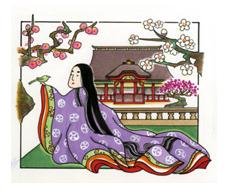Hakata Culture vol.34
Plum Blossom Viewing is En Vogue!

Dazaifu Tenmangu is widely known as the perfect place for students to pray for success in exams, but did you know that it is also famous for a legendary plum blossom called tobiume ("flying plum")? Based on the tragic story of Sugawara no Michizane, a historic figure of the Heian era, who was unjustly banished from Kyoto and sent to Dazaifu. Legend has it a plum tree, touched by his story, flew to Dazaifu to follow the master. Now, the plum trees, 10 generations after the original, welcome you on the right side toward the main building of the shrine. The plum tree is not only the symbol of Dazaifu Tenmangu but, more importantly, the flower of Fukuoka Prefecture.
As for the origin of plum trees, there are some competing theories. Some believe that they originally grew in the northern part of Kyushu; others believe the Japanese envoy to the Tang Dynasty brought them here with other items of Chinese culture, thinking them precious medication.
Plum blossoms begin to bloom, if the weather stays fine, in the middle of January, coming to full bloom in the middle of February. Tobiume, blooming a little earlier than the other 300 kinds, is cherished as a reminder of the coming of spring, and this, combined with uguisu (the bird whose song signals the arrival of spring), often appear on hanafuda (Japanese flower cards.)
From the middle of February to the middle of March is the perfect time to enjoy plum blossom viewing. Why not take up this fashionable pastime, before cherry blossom season?
Plum Blossom Spots
- Dazaifu Tenmangu: 6,000 fragrant plum blossoms of various types.
- Maizuru Koen: 220 white and 150 red plum blossoms, close to Ohori Koen and also famous for cherry blossoms.
- Kofuji Bairin: 3,000 plum blossoms, with a fine view of the coastline in Itoshima.
A public relations manager
Kimiyo Sasaki
![]() Spot info-Tourist information portal site, FUKUOKA CITY GUIDE YOKANAVI
Spot info-Tourist information portal site, FUKUOKA CITY GUIDE YOKANAVI
今年は「梅見」としゃれこもう!
2月といえば「梅」でしょう。受験シーズン間近になって来ると、福岡県内だけではなく、九州各地から合格祈願のためにたくさんの受験生が集まってくるのが太宰府天満宮。そして太宰府天満宮といえば「飛梅とびうめ」です。天神様と呼ばれる天満宮の祀神・菅原道真が都から九州に左遷されてきたとき、後を慕って飛んできたという哀しくも美しい物語があります。本殿に向かって右側に鎮座していますが、もちろんこの「飛梅」は樹齢150年ほどで、飛んできてから10代目にあたるとか。全国に数ある天満宮の紋(ロゴマーク)は現在も梅マークであり、福岡県の花「県花」でもあります。
さてこの「梅」ですが、古くから九州北部に自生していたという説もありますが、奈良時代以前に遣唐使が薬の木として他の中国文化とともに持ち帰ったものといわれています。当時から多くの日本人に愛され、平安時代には広く普及したそうで、「万葉集」にも萩の花に次いで2番目に梅の花を歌ったものが多いようです。
1月中旬くらいになって暖かい日がつづくと「飛梅」はほころびはじめ(花が2、3輪開くこと)、2月半ばころには満開となります。品種は300種以上あるといわれ、ここの飛梅は早咲き種なので、普通に見る梅よりも早く咲く種類です。福岡では早春を告げる季節の風物詩なのです。そして、梅といえば鶯うぐいす、ホーホケキョの鳴き声で有名ですが、こちらも春告鳥はるつげどりの異名を持ち、このセットは「花札」でおなじみのデザインです。例年だと2月中旬から3月中旬までが梅の花が楽しめる時期、花見といえば桜ですが、香り高い梅見というのも一興です。
<梅の見所>
- 太宰府天満宮…6000本(梅の種類も多く、梅の香りも楽しめる)
- 舞鶴公園…白梅220本 紅梅150本(大濠公園からすぐ、桜も有名)
- 小富士梅林…3000本(糸島の船越湾を望む景色も美しい)
福岡市広報課長 佐々木 喜美代

